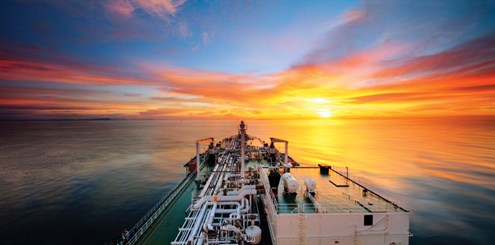Business Trends: Four challenges to Australia’s rising role in the global LNG market
The past 10 yr have been the decade of natural gas, but the next 10 yr will belong to LNG as countries race to build out their export capacity.
The rise of LNG goes hand in hand with natural gas’ role as an increasingly critical component of the global energy market in the next few decades, as demand for energy continues to rise to meet the lighting, heating, cooling and transport needs of a growing global population. According to Shell’s 2019 LNG outlook, LNG will meet 40% of expected energy growth by 2035.
With immense opportunity on a global scale, the race to build export infrastructure will see long-standing leaders replaced by up-and-comers—countries that, for two decades, saw their conventional gas supplies dwindle. Qatar will be the first to lose the title of the world’s largest LNG exporter—a position the country has held since 2006.
The competition? Australia.
Australia’s rise to No. 1. Over the past decade, Australia has been setting the stage to become the world’s largest LNG exporter, with long-term investments in new LNG projects. Since 2012, Australia has brought eight LNG export projects online.
Earlier this summer, Australia’s export capacity finally outstripped Qatar when Shell’s Prelude FLNG barge project in northwestern Australia came online. Now, global LNG markets wait for Australia to steadily operate at full capacity. Once that happens, it will replace Qatar as the world’s leading exporter of LNG. Australia has already exported more LNG than Qatar in both November 2018 and April 2019.
Australia’s path to become the world’s largest LNG exporter is not without challenges (Fig. 1). Four issues the Australian LNG industry will face in the decades to come are outlined in the following sections.
 |
| Fig. 1. Australia will face several challenges to growing its LNG export business, including constraints on LNG supply, competition from other exporters, opposition from domestic environmentalists, and uncertainties about the longevity of global LNG demand. |
Challenge #1: Constraints on LNG supply. Enthusiasm for Australia’s LNG is booming, and experts predict that 80% of the country’s domestic gas production will be used for LNG exports by 2020. This has serious implications for domestic supply and demand.
Prior to unconventional production techniques that unlocked enormous potential in Australia’s western provinces, most of Australia’s natural gas came from abundant supplies of coalbed methane in Queensland on the east coast. As demand for LNG skyrocketed across the Asia-Pacific region, the timing coincided with dwindling supplies of coalbed methane in eastern Australia.
At the same time, global LNG prices were fluctuating and threatening profits. Due to this uncertainty, many of Australia’s early LNG exporters locked in long-term contracts to Japan, China and South Korea.
Due to these long-term international contracts, the LNG exporters drew upon Queensland’s declining domestic supplies of natural gas, ultimately driving up domestic prices and political tensions. To solve this problem, eastern Australia was forced to import LNG from Australia’s northwestern provinces, where five new LNG export projects have come online since 2012.
While the increase in export projects on the west coast has solved the issue for now, there will always be a push-and-pull between Australia’s domestic market and its international export opportunities.
Challenge #2: Adversaries at home. Like many countries, Australia’s energy industry—and especially its rising LNG industry—is continuously under scrutiny by environmental groups.
Australia briefly enacted a carbon tax in 2012, but ultimately overturned it by 2014. Adversaries of the LNG industry point to the continued rise of greenhouse gas emissions every year since 2014, despite the government’s assurances that natural gas will lower emissions as the country shifts away from coal. While CO2 emissions from electricity generation continue to fall, overall emissions grew as a result of the expanding LNG export industry.
Since 2014, environmental activists have decried the year-on-year increase in GHG emissions and have achieved several full or partial fracking bans in key areas. While two of these bans were recently overturned at the provincial level, Australia’s energy industry is subject to the changing regulations of whichever political party is in power. While the LNG industry is thriving today, there is no promise that this could not change under a new government.
Challenge #3: The competition. Australia’s LNG exports are now a US$32-B/yr industry. Regardless of how successful Australia is in scaling its LNG export industry, though, it will face fierce competition from major energy exporters around the world. Over the next decade, countries will see their market share rise and fall as the race for LNG export capacity heats up.
Qatar. Despite soon losing the LNG crown to Australia, Qatar will continue to be a major LNG exporter for decades to come. Like Australia and the U.S., Qatar is still ramping up its export capacity with its North Field Expansion project. This plan is projected to increase the country’s capacity by 43% by 2024. The question is: Will this be enough to help Qatar regain the status it will lose in the near future, as Australia consistently exports at its full capacity?
Likely not. As other players build out their planned export capacity, Qatar will see its share of global LNG exports decrease. Still, Qatar’s LNG exporters will target European and African markets in addition to the growing demand in the APAC region, making it a competitive force against Australia’s LNG exports.
The U.S. The International Energy Agency (IEA) estimates that the U.S. will be the largest LNG exporter within the next 5 yr, despite efforts by both Qatar and Australia to increase capacity.
In 2019, the U.S., which has been exporting LNG only since 2016, became the world’s third-largest exporter of LNG. By 2021, the U.S. will have six liquefaction projects, with another two expected to come online by 2025. In 2024, experts project that the world’s largest producer of natural gas will replace Australia as the new leader of LNG exports, surpassing 100 Bm3.
The U.S. also has the geographic advantage of access to both European and Asian markets. With the majority of export facilities located along the U.S. Gulf Coast, Europe in particular is an attractive export destination. In fact, the U.S. Energy Information Administration (EIA) indicates that U.S. exports to Europe overtook exports to Asia for the first time in January 2019. Also in 2019, Europe has accounted for almost 40% of U.S. LNG exports. This market will likely remain attractive for U.S. exporters as the Trump administration seeks to build long-term LNG relationships in Europe while ramping up tariffs against China, one of the world’s largest LNG importers.
Russia. The natural gas industry in Russia benefits from geographic proximity to high-demand markets in both China and Europe.
A large driver of Russia’s natural gas export industry is its pipeline access to importing countries. While Russian companies’ exports to Europe in late 2019 were down 4.5% over 2018 levels, the country is constructing the Nord Stream 2 gas pipeline in the Baltic Sea and the TurkStream pipeline in the Black Sea, both of which will greatly expand delivery capacity. Along with the Power of Siberia pipeline to China, these pipeline projects will increase Russia’s export capacity by 168 Bm3.
While Russia has focused on pipelines over the last decade, it is looking to become a global leader in LNG exports by 2030. Russian export companies like Novatek are partnering with major players in Japan and China to build out capacity in the Arctic. In 2018, Russia exported 8% of the global LNG market and aims to increase that share to 20% by 2035.
With the world’s largest natural gas reserves, Russia’s aggressive plans to expand LNG exports will have a significant impact on the global natural gas and LNG markets as the country ramps up export capacity in the next decade.
Canada. As the fifth-largest producer of natural gas, Canada is poised to be a significant player on the global LNG export stage.
While U.S. and Canadian natural gas markets are historically interconnected, the rise of unconventional shale production in both countries is changing the energy supply and, subsequently, its import/export relationship. Faced with an oversupply, Canada has expressed plans to build out its export capacity.
Like the U.S. and Australia, Canada is geographically well-positioned to meet growing LNG demand. Canada’s resources are positioned in the western provinces—ideally situated for exports to Asian importers.
At present, 13 of Canada’s 18 proposed export facilities are located in British Columbia. While Canada is still in the early stages of its LNG capacity buildout, one of the country’s LNG exporters, FortisBC, recently signed Canada’s first binding supply agreement with China. The company has been exporting small quantities to China since 2017, relying on vessels and strategically circumventing the need for an expensive export facility. However, this new, long-term contract could be an impetus to move Canada’s LNG industry forward.
Canada’s LNG exports have potential, but they do face headwinds as companies reevaluate the economics and long-term commitments of building new, large-scale LNG projects, especially as this market becomes more competitive.
Challenge #4: The longevity of global LNG demand. With excess supply driven by shale gas and the rising export capacity of countries like Australia, the LNG market is facing a surplus, as projected demand has yet to catch up to supply. Just this year, gas prices plummeted in both Europe and Asia.
Most experts agree that this glut will likely last through 2020, until demand starts catching up with capacity in the mid-2020s. Due to this expected trend, the market is becoming increasingly competitive, long-term contracts are on the rise, and suppliers are exploring new markets.
The question is: How long can Australian exporters withstand low prices?
The global LNG market requires expensive infrastructure projects and depends on steady demand of natural gas in the long term. As the Center for Strategic and International Studies recently noted, if major importers like China suddenly change course with their domestic energy policy, then the entire industry would face a disastrous oversupply.
Driving profit for LNG in an uncertain market. Australia’s growing LNG industry faces many challenges, both at home and abroad. Domestically, Australia’s LNG producers will continue to face constraints in balancing domestic consumption vs. global exports and environmental activism that could threaten the industry.
On the global scale, fierce competition and oversupply will continue to be the reality in the short term, but the potential for growing demand and higher prices is just a few years away as demand continues to grow in both Asia and Europe.
To face the certainty of market volatility, all LNG market participants—both in Australia and around the world—need flexible, scalable commodity trading and risk management solutions that provide visibility into a complex, global supply chain, and the flexibility to react to a fluctuating market. GP
 |
David Gross is Vice President of Product Management at ION Commodities. He has extensive product background in energy trading and risk management software, with experience in the natural gas, power and bulk commodities markets. Mr. Gross has worked with the Openlink suite of products for more than 13 yr and is based in Long Island, New York.




Comments